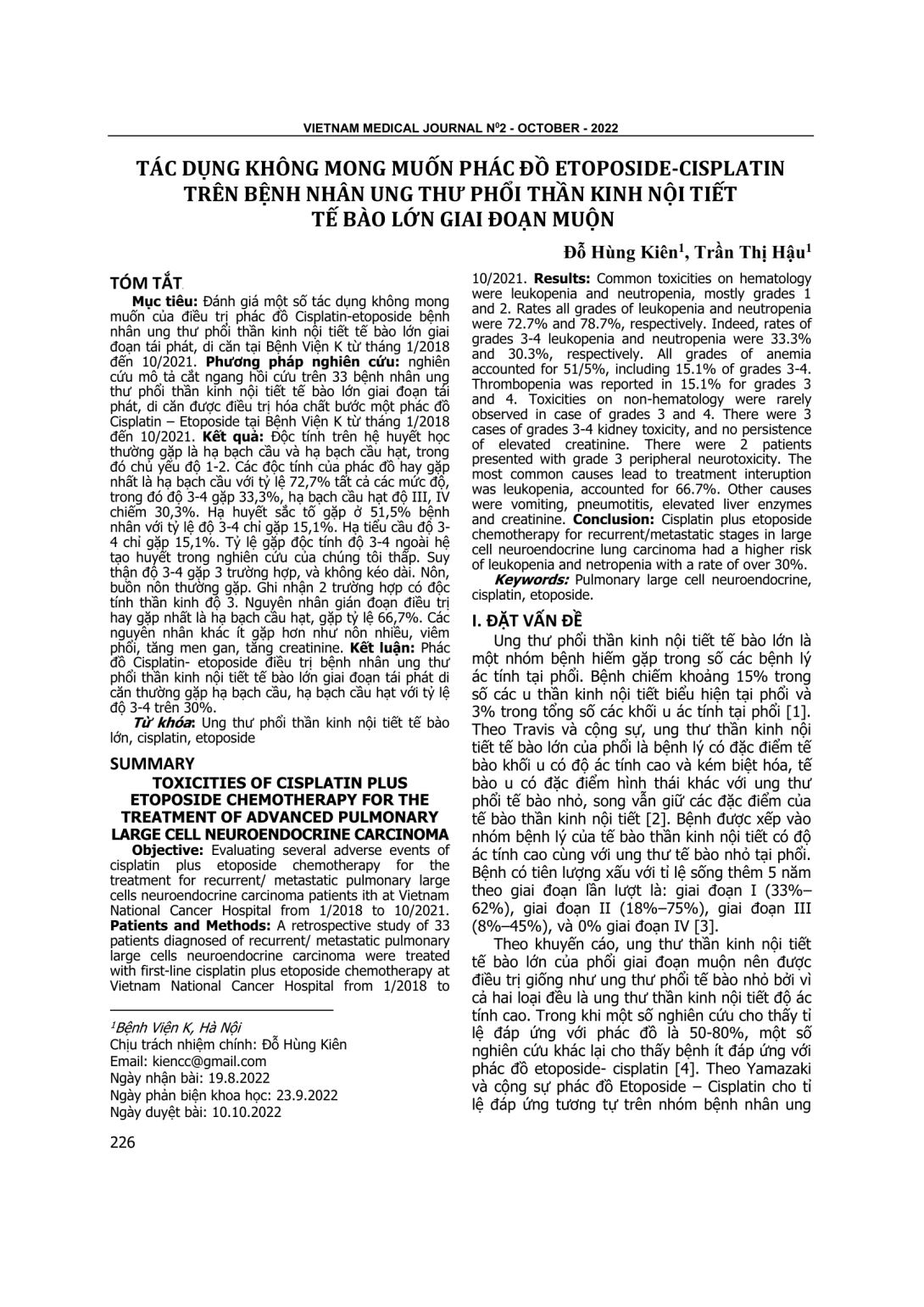
Đánh giá một số tác dụng không mong muốn của điều trị phác đồ Cisplatin-etoposide bệnh nhân ung thư phổi thần kinh nội tiết tế bào lớn giai đoạn tái phát, di căn tại Bệnh Viện K từ tháng 1/2018 đến 10/2021. Phương pháp nghiên cứu: nghiên cứu mô tả cắt ngang hồi cứu trên 33 bệnh nhân ung thư phổi thần kinh nội tiết tế bào lớn giai đoạn tái phát, di căn được điều trị hóa chất bước một phác đồ Cisplatin – Etoposide tại Bệnh Viện K từ tháng 1/2018 đến 10/2021. Kết quả: Độc tính trên hệ huyết học thường gặp là hạ bạch cầu và hạ bạch cầu hạt, trong đó chủ yếu độ 1-2. Các độc tính của phác đồ hay gặp nhất là hạ bạch cầu với tỷ lệ 72,7% tất cả các mức độ, trong đó độ 3-4 gặp 33,3%, hạ bạch cầu hạt độ III, IV chiếm 30,3%. Hạ huyết sắc tố gặp ở 51,5% bệnh nhân với tỷ lệ độ 3-4 chỉ gặp 15,1%. Hạ tiểu cầu độ 3-4 chỉ gặp 15,1%. Tỷ lệ gặp độc tính độ 3-4 ngoài hệ tạo huyết trong nghiên cứu của chúng tôi thấp. Suy thận độ 3-4 gặp 3 trường hợp, và không kéo dài. Nôn, buồn nôn thường gặp. Ghi nhận 2 trường hợp có độc tính thần kinh độ 3. Nguyên nhân gián đoạn điều trị hay gặp nhất là hạ bạch cầu hạt, gặp tỷ lệ 66,7%. Các nguyên nhân khác ít gặp hơn như nôn nhiều, viêm phổi, tăng men gan, tăng creatinine. Kết luận: Phác đồ Cisplatin- etoposide điều trị bệnh nhân ung thư phổi thần kinh nội tiết tế bào lớn giai đoạn tái phát di căn thường gặp hạ bạch cầu, hạ bạch cầu hạt với tỷ lệ độ 3-4 trên 30%.
Evaluating several adverse events of cisplatin plus etoposide chemotherapy for the treatment for recurrent/ metastatic pulmonary large cells neuroendocrine carcinoma patients ith at Vietnam National Cancer Hospital from 1/2018 to 10/2021. Patients and Methods: A retrospective study of 33 patients diagnosed of recurrent/ metastatic pulmonary large cells neuroendocrine carcinoma were treated with first-line cisplatin plus etoposide chemotherapy at Vietnam National Cancer Hospital from 1/2018 to 10/2021. Results: Common toxicities on hematology were leukopenia and neutropenia, mostly grades 1 and 2. Rates all grades of leukopenia and neutropenia were 72.7% and 78.7%, respectively. Indeed, rates of grades 3-4 leukopenia and neutropenia were 33.3% and 30.3%, respectively. All grades of anemia accounted for 51/5%, including 15.1% of grades 3-4. Thrombopenia was reported in 15.1% for grades 3 and 4. Toxicities on non-hematology were rarely observed in case of grades 3 and 4. There were 3 cases of grades 3-4 kidney toxicity, and no persistence of elevated creatinine. There were 2 patients presented with grade 3 peripheral neurotoxicity. The most common causes lead to treatment interuption was leukopenia, accounted for 66.7%. Other causes were vomiting, pneumotitis, elevated liver enzymes and creatinine. Conclusion: Cisplatin plus etoposide chemotherapy for recurrent/metastatic stages in large cell neuroendocrine lung carcinoma had a higher risk of leukopenia and netropenia with a rate of over 30%.
- Đăng nhập để gửi ý kiến
